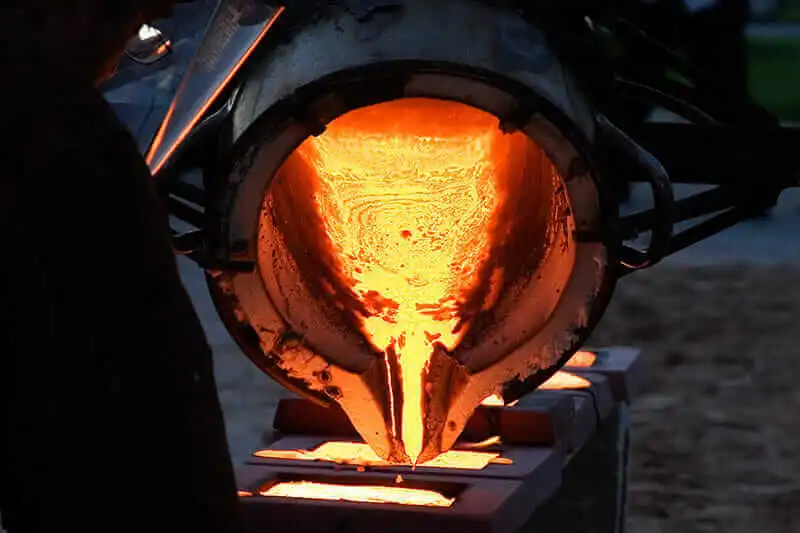Metal Casting Processes: A Basic Overview
With origins tracing back over 5,000 years, metal casting remains an essential manufacturing process for critical components in automobiles, aircraft, ships, heavy equipment, machine tools, and plant machinery. This article explores metal casting, elucidating the technique, its benefits, and versatile applications. Gain fundamental knowledge of how this enduring industrial process delivers precision metal parts at high volumes.

Metal Casting
Metal casting shapes materials by pouring molten metal from a crucible into molds containing hollow cavities that define the desired forms. Once poured, the liquid metal solidifies inside the mold cavity, enabling removal of the newly cast part. This technique produces metal components of varying geometries and sizes, from simple to complex. By precisely controlling mold design, metallurgists leverage casting to create essential metal parts, including titanium sputtering targets made through the careful casting of molten titanium metal. With versatility and precision, metal casting proves critical for manufacturing intricate titanium and other metal components.
Metal casting builds upon ancient manufacturing processes to produce robust, intricate components. Mold materials like heat-resistant sand withstand molten metal's high temperatures during casting. Permanent metal molds also shape cast parts. Careful mold design confers desired geometries. Casting's mold versatility enables manufacturing various components with enhanced strength and rigidity. This process leverages strategic materials to impart durability through solidified molten metal's molded form.
The process of Metal Casting Processed
Metal casting is a manufacturing process where liquid metal is poured into a mold and allowed to solidify, taking the shape of the mold cavity. The steps in the metal casting process are:
Mold preparation
The mold is made of heat resistant materials like sand, clay, metal or ceramic. The mold cavity is shaped to produce the desired part geometry.
Melting metal
The selected metal is melted in a furnace until it liquefies and can flow into the mold. Common cast metals include iron, aluminum, steel, copper alloys and magnesium alloys.
Pouring and filling
The molten metal is carefully poured into the mold cavity. It fills the entirety of the cavity taking its shape.
Cooling and solidifying
The filled mold sits undisturbed as the metal solidifies and cools, typically aided by water sprays or air jets.
Removal
Once fully solidified, the casting is removed manually or using vibrations to separate it from the mold.
Finishing
The cast part may undergo various finishing steps like sprue removal, sanding, grinding or polishing to achieve the final part dimensions, surface quality and appearance.
Inspection
The final casting is inspected for defects to ensure it meets engineering quality standards before shipment.
Advantages
l Ability to produce complex geometries - Intricate cast part designs are possible including internal features like cavities, cores, and tunnels.
l High production rate - Casting is suitable for high volume manufacturing due to its fast production rates and low labor requirements.
l Economy of scale - Larger production volumes lead to lower per unit costs.
l Wide material options - Most metals can be cast including aluminum, steel, iron, bronze, magnesium, and more.
l Good mechanical properties - The rapid cooling during solidification results in fine microstructures that improve strength.
l Dimensional accuracy - Modern casting has high geometric accuracy for most applications.
l Surface finish - Cast surfaces can be smooth and burr-free with only minor finishing required.
l Allows consolidation - Multiple components can be cast as a single part.
l Low equipment costs - Compared to other processes like machining, casting equipment is relatively inexpensive.
Applications of Metal Casting
Automobile and heavy equipment manufacturing employs over 50% of metal casting applications, making this sector the predominant user of cast components. With versatility allowing intricate geometries across diverse materials, metal castings prove vital for nearly every industrial manufacturing process. From engine blocks to turbine blades, cast parts deliver critical durability, performance, and economics.
l Automotive - Engine blocks, wheels, brake components, drivetrain parts, etc. Casting allows complex designs at high volumes.
l Aerospace - Turbine blades, landing gear, engine parts, airframe components. Tight tolerances and exotic alloys.
l Construction - Manhole covers, grates, valves, pipes, joints. Durable infrastructure parts.
l Machinery - Gears, pulleys, mold bases, machine tool beds, engine parts. High strength and wear resistance.
l Consumer goods - Decorative furniture parts, wood stove grates, cookware. Detailed artistic pieces.
l Medical - Dental implants, prosthetics, surgical instruments. Biocompatible alloys.
l Military - Firearm components, armor, missile casings. Rugged and heat resistant materials.
l Power and energy - Turbine rotors, solar cell frames, battery casings, generator parts. High integrity components.
l Piping - Elbows, tees, couplings, fixtures, valves. Corrosion resistant alloys.
l Electronics - Heat sinks, semiconductor packages, housing and enclosures. Heat dissipation and shielding.
Conclusion
Spanning transportation, heavy equipment, aerospace, machinery, art, and beyond, metal casting drives manufacturing across sectors. This versatile industrial process enables high volume production of durable, intricate metal components. With unparalleled shape complexity and material diversity, metal casting proves essential for the robust parts needed in automotive, aircraft, defense, construction, and other industries. Precision engineered castings deliver optimized performance, longevity, and economics wherever operational demands run high.
